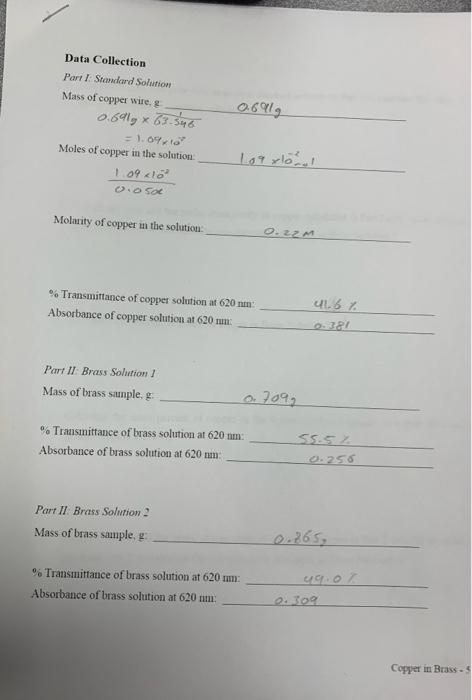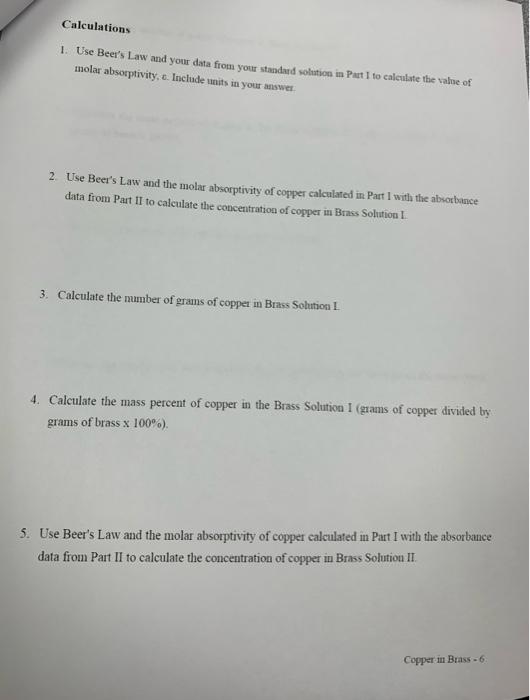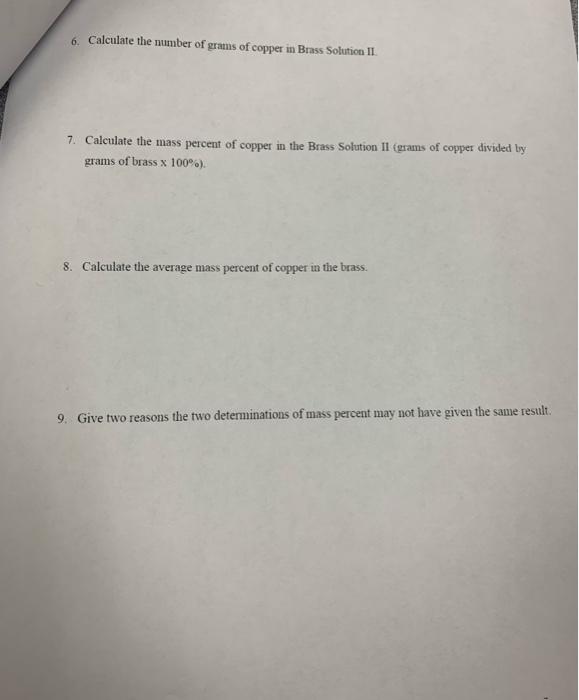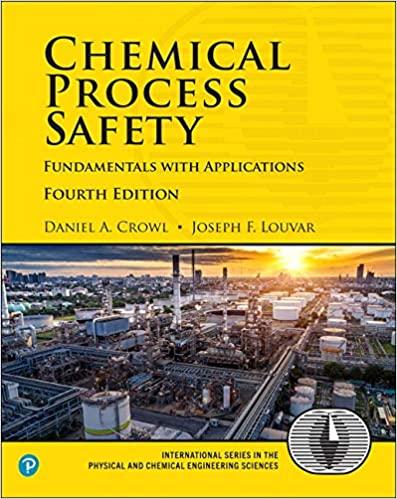0.649 Data Collection Part I: Standard Solution Mass of copper wire. 0.691 x 63.546 = 1.04*** Moles of copper in the solution: 1.09 lo 0.050 109xlo Molarity of copper in the solution: O.ZA Transmittance of copper solution at 620nm Absorbance of copper solution at 620 mm. 416% 0324 Part II Brass Solution ! Mass of brass siunpleg 0.7092 % Transmittance of brass solution at 620 mm: Absorbance of brass solution at 620nm. ss.5 0.250 Part II Brass Solution 2 Mass of brass sample, % Transmittance of brass solution at 620 num: Absorbance of brass solution at 620 mm: 0.309 Copper in Brass Calculations 1. Use Beer's Law and your data from your standard solution in Put I to calculate the value of molar absorptivity, t. Include mits in your answer 2. Use Beer's Law and the molar absorptivity of copper calculated in Part I with the absorbance data from Part II to calculate the concentration of copper in Brass Solution 1 3. Calculate the number of grams of copper in Brass Solution 4. Calculate the mass percent of copper in the Brass Solution I (grams of copper divided by grams of brass x 100%) 5. Use Beer's Law and the molar absorptivity of copper calculated in Part I with the absorbance data from Part II to calculate the concentration of copper in Brass Solution II. Copper in Brass - 6 6. Calculate the number of grams of copper in Brass Solution II 7. Calculate the mass percent of copper in the Brass Solution II (grams of copper divided by grams of brass x 100%). 8. Calculate the average mass percent of copper in the brass. 9. Give two reasons the two determinations of mass percent may not have given the same result. Procedures Part I: Standard Solution 1. Weigh 0.60-0.90 g of copper wire to the nearest mg. Record all digits of the mass. 2. Place in a 150 mL beaker. 3. In the FUME HOOD, add 10 mL of concentrated nitric acid, HNO). Safety: HNO, is a strong acid. Wear gloves and use with caution. If you get HNO, on you, immediately put affected area under running water and report to TA. The brown gas (NO2) is toxic; keep beaker in fume hood until Cu is dissolved and no brown gas appears. 4. When the Cu is dissolved and the gas generation stops, with the beaker still in the fume hood, add 15 mL of distilled water. 5. Transfer to a 50 mL volumetric flask and dilute to the mark with distilled water. 6. Measure the Transmittance of the solution at 620 nm. Part II: Brass Solution 1 1. Weigh 0.60-0.90 g of the brass sample to the nearest mg. 2. Place in a 150 mL beaker. 3. In the FUME HOOD, add 10 mL of concentrated nitric acid, HNOJ. Safety: The brown gas (NO:) is toxic, keep beaker in fume hood until Cu is dissolved and no brown gas appears. If you get HNO, on you, immediately put affected area under running water and report to TA The brown gas (NO2) is toxic: keep beaker in fume hood until Cu is dissolved and no brown gas appears. 4. When the Cu is dissolved and the gas generation stops, with the beaker still in the fume hood, add 15 mL of distilled water. 5. Transfer to a 50 mL. volumetric flask and dilute to the mark with distilled water. 6. Measure the Transmittance of the sample at 620nm. Part II: Brass Solution 2 1. Repeat procedures of Brass solution 1













